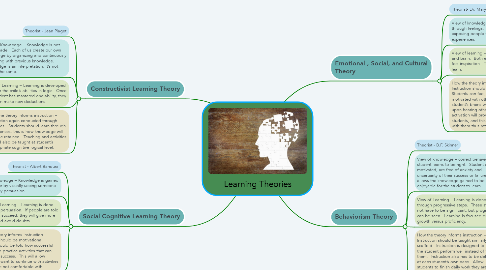Learning Theories
by Theresa King

1. Emotional , Social, and Cultural Theory
1.1. Theorist- Dr. Mary Helen Immordino-Yang
1.2. View of knowledge – Knowledge is gained through feelings. Knowledge is gained by exposing people to other people’s experiences.
1.3. View of learning – Inspiration impacts body and brain. Both entities work together to feel inspiration. This motivates people to learn.
1.4. How the theory informs instruction – Instruction should be inspirational based. Students can feel, empathize, and become motivated with others grit. Areas in student’s brains will become activated upon hearing other’s stories. This activation will provide a feeling to students, and this feeling will then stay with them thus retaining knowledge.
2. Behaviorism Theory
2.1. Theorist - B.F. Skinner
2.2. View of knowledge – correct behavior, the student learns to be right. Student are motivated, are free of anxiety and uncertainty of their success or failure. This allows the knowledge gained to be enjoyable for the student to learn.
2.3. View of Learning – Learning is done through progressive steps. These steps do not have to be significant, but progression can be seen. Learning is focused on growth versus proficiency.
2.4. How the theory informs instruction – Instruction should be taught similarly to a scaffold. Instruction is designed to help the student perform well instead of testing them. Instruction also has to be delivered at each student’s own pace. Allow students to finish daily work they are assigned and this will allow them to finish work scheduled for the next day. Assessment results in the classrooms must be immediate
3. Constructivist Learning Theory
3.1. Theorist - Jean Piaget
3.2. View of Knowledge – Knowledge is not ready made. Each of us create our own knowledge by organizing and continuously interacting with previous knowledge. Knowledge is an interpretation, it’s not always the same.
3.3. View of Learning – Learning is developed through the child’s abilities in logic. Once the student has mastered one ability, they can then make new deductions.
3.4. How the theory informs instruction – Instruction again conducted through activities. Students should learn through experiences, this is how knowledge will best be retained. Teaching and activities should also be taught at student’s appropriate cognitive logical level.
4. Social Cognitive Learning Theory
4.1. Theorist - Albert Bandura
4.2. View of Knowledge – Knowledge is gained socially either by visually seeing someone doing it or by persuasion.
4.3. View of Learning – Learning is done through persuasion. If people are told they can succeed, they will give more effort and avoid doubts.
4.4. How the theory informs instruction – Instruction should be motivational. Students should be told how successful they are and practice activities that can add to that success. This will allow students to want to continue with activities that they are not comfortable with.


